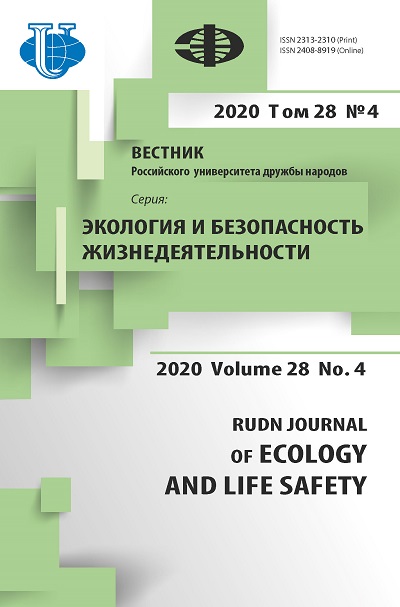Change of phytotoxicity of soils contaminated with oil products in the process of their microbiological remediation during the application of humic preparations
- Authors: Cherdakova A.S.1, Galchenko S.V.1
-
Affiliations:
- Ryazan State University named for S. Yesenin
- Issue: Vol 28, No 4 (2020)
- Pages: 336-348
- Section: Geoecology
- URL: https://journals.rudn.ru/ecology/article/view/27348
- DOI: https://doi.org/10.22363/2313-2310-2020-28-4-336-348
Cite item
Full Text
Abstract
The article presents the results of experimental studies on the assessment of the phytotoxicity of soils contaminated with oil products of various fractions (gasoline, diesel fuel, fuel oil) in the process of their microbiological remediation with the introduction of humic preparations. The studies were carried out under the conditions of a vegetation experiment, in which the processes of bioremediation of soils contaminated with various oil products were simulated using microbiodestructors and humic preparations (“Ekorost” and “Gumi”). It has been established that the implementation of bioremediation measures using microbio-destructors does not allow for complete detoxification of soil contaminated with various oil products. The manifestation of detoxifying properties of humic preparations in relation to oil-hydrocarbon pollution of soils during their bioremediation was revealed. The severity of these properties varies and depends on the type of oil-polluting product, its concentration, as well as on the properties of the preparations themselves.
About the authors
Alina S. Cherdakova
Ryazan State University named for S. Yesenin
Author for correspondence.
Email: cerdakova@yandex.ru
SPIN-code: 5372-7424
Candidate of Biological Sciences, Associate Professor, Department of Geography, Ecology and Nature Management
46 Svobody St, Ryazan, 390000, Russian FederationSvetlana V. Galchenko
Ryazan State University named for S. Yesenin
Email: s.galchenko2017@yandex.ru
SPIN-code: 1524-2513
Candidate of Biological Sciences, Associate Professor, Department of Biology and Methods of its Teaching
46 Svobody St, Ryazan, 390000, Russian FederationReferences
- Liu Q, Tang J, Gao K, Giesy JP. Aerobic degradation of crude oil by microorganisms in soils from four geographic regions of China. Scientific Reports. 2017;7(Part C):15-38. http://dx.doi.org/10.1038/s41598-017-14032-5
- Atlas RM, Hazen ТС. Oil biodegradation and bioremediation: A tale of the two worst spills in US history. Environmental Science & Technology. 2011;45(16):67-75. http://dx.doi.org/10.1021/es2013227
- Brown LD, Cologgi DL, Gee KF, Gee F, Ulrich AC. Bioremediation of oil spills on land. New Jersey: John Wiley & Sons, Hoboken; 2015.
- Edmo MR, Karlos KHM, Marcos TR. Prospect, isolation, and characterization of microorganisms for potential use in cases of oil bioremediation along the coast of Trindade Island, Brazil. Journal of Environmental Management. 2015;156:15-22. http://dx.doi.org/10.1016/j.jenvman.2015.03.016
- Vineetha V, Shibu К. Bioremediation of oil contaminated soil. 2012 International Conference on Green Technologies (ICGT), 18-20 December 2012, Trivandrum, India. New York: IEEE; 2012. p. 64-77. http://dx.doi.org/10.1109/ICGT.2012.6477954
- Liang Y-N, Britt DW, McLean JE, et al. Humic acid effect on pyrene degradation: finding of an optimal range for pyrene solubility and mineralization enhancement. Appl. Microbiol. Biotechnol. 2007;74:1368-1375. http://dx.doi.org/10.1007/s00253-006-0769-8
- Lipczynska-Kochany E. Humic substances, their microbial interactions and effects on biological transformations of organic pollutants in water and soil: a review. Chemosphere. 2018;202:420-437. http://dx.doi.org/10.1016/j.chemosphere.2018.03.104
- Ivanov AA, Yudina NV, Maltseva EV, Matis EYa, Svarovskaya LI. Stimulation of the activity of microorganisms by humin preparations in oil-polluted soils. Eurasian Soil Science. 2010;43:210-215. http://dx.doi.org/10.1134/S1064229310020110
- Grechishcheva NY, Meshcheryakov SV, Perminova IV, Kholodov VA. Stabilization of oil-in-water emulsions by highly dispersed particles: role in self-cleaning processes and prospects for practical application. Russian Journal of General Chemistry. 2017;87: 2166-2180. http://dx.doi.org/10.1134/S1070363217090432
- Гречищева Н.Ю. Разработка научных основ применения гуминовых веществ для ликвидации последствий нефтезагрязнения почвенных и водных сред : дис.. д-ра хим. наук. М., 2016. 326 с.
- Степанов А.А., Госсе Д.Д., Панина М.А. Применение гуминового препарата «Питер-Пит» для детоксикации и рекультивации нефтезагрязненной почвы // Проблемы агрохимии и экологии. 2018. № 1. С. 55-57.
- ГОСТ 17.4.3.01-2017. Охрана природы (ССОП). Почвы. Общие требования к отбору проб. М. : Стандартинформ, 2019. 9 с.
- Beškoski VP, Milic J, Gojgic-Cvijovic GD, Ilic M. Bioremediation of soil polluted with crude oil and its derivatives: microorganisms, degradation, pathways, technologies. Hemijska Industrija. 2019;74(4):455-460. http://dx.doi.org/10.2298/HEMIND110824084B
- ГОСТ Р ИСО 22030-2009. Качество почвы. Биологические методы. Хроническая фитотоксичность в отношении высших растений. М. : Стандартинформ, 2011. 33 с.
- Yang Yu, Shu L, Wang X, Xing B, Tao S. Mechanisms regulating bioavailability of phenanthrene sorbed on a peat soil-origin humic substance. Environmental toxicology and chemistry. 2012;31(7):1431-1437. http://dx.doi.org/10.1002/etc.1844
















